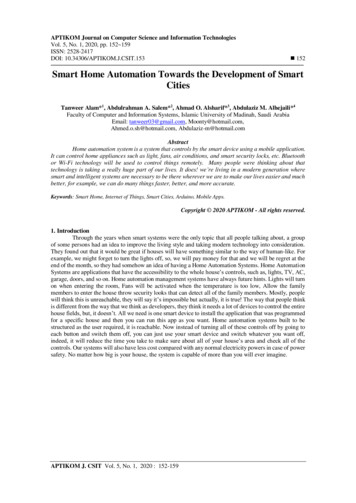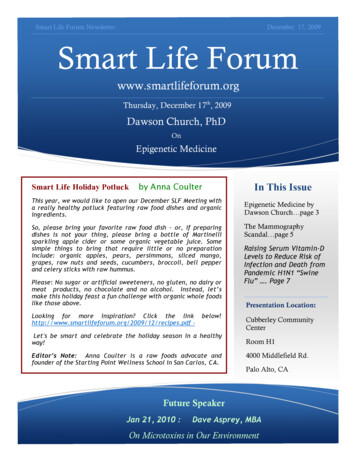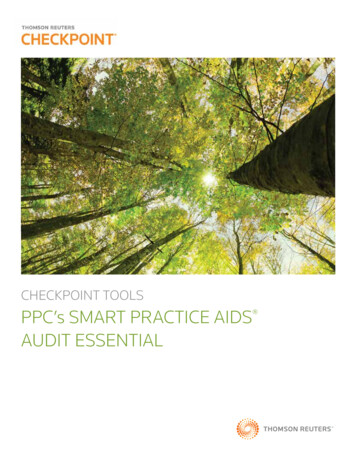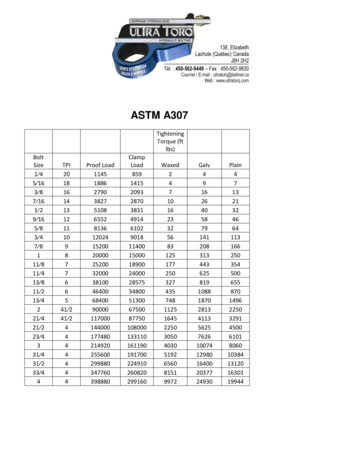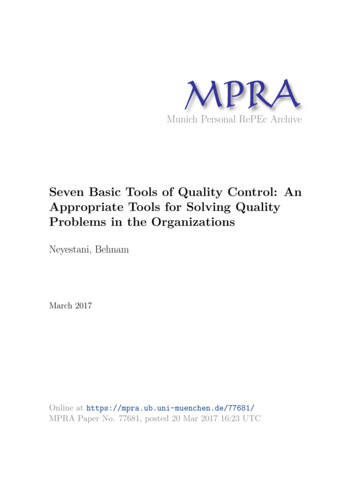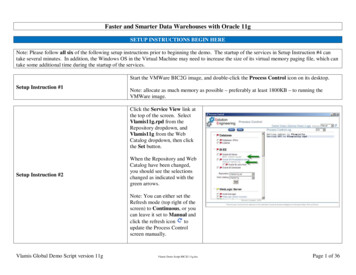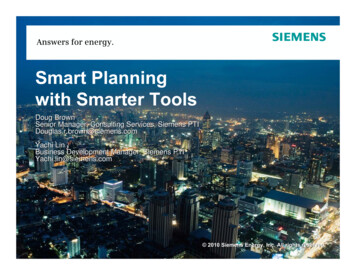
Transcription
Answers for energy.Smart Planningwith Smarter ToolsDoug BrownSenior Manager, Consulting Services, Siemens PTIDouglas.r.brown@siemens.comYachi LinBusiness Development Manager, Siemens PTIYachi.lin@siemens.com 2010 Siemens Energy, Inc. All rights reserved.
Characteristics of Today’s Transmission SystemsReliable on a system-basis Reliability may vary by location Prevalence of remedial measures to relieve potential cascading problemsDesigned to survive severe, probable events Deterministic criteria, typically Without explicitly predicting likelihood of occurrenceDifferent methods for different levels Generation level, using probabilistic methods Transmission level, using deterministic methods Distribution level using performance-based decisionsPage 2 2010 Siemens Energy, Inc. All rights reserved.Siemens Power Technologies International
Understanding Margins in Transmission SystemsMapping the Challenges with the ToolsWill the loss of one element trigger the lossof other elements?How can I identify methods relief, a violation,in a timely manner?Cascading TrippingForecastAutomatic CorrectiveAction IdentificationWill my system improvement pay back?How do I perform breaker-to-breakercontingency analysis?Substation ReliabilityAnalysisWhat is the best bus configuration forimproved reliability?Variable EnergyResource ModelsHow do I integrate all my projects into theinterconnection queue?Model on DemandHow do I bridge the gap between operationsand planning modeling?Page 3Unified TransmissionModel 2010 Siemens Energy, Inc. All rights reserved.Siemens Power Technologies International
Different Perspectives in Contingency PlanningSystem modeling considerations Load/generation imbalance Network separation Special protection systems, remedialaction schemes Operator actions Cascading trippingNorthernSystemCustomerCustomers impact considerations Isolation of load supplying substationfrom network. Initiation of a trip sequence, whichisolates or trips loads. Load CurtailmentPage 4LoadArea25 MW of load iscurtailed on outageof a circuitSouthernSystemSystemLine is overloadedfor outage of aparallel circuit 2010 Siemens Energy, Inc. All rights reserved.Siemens Power Technologies International
Deterministic vs Probabilistic ApproachesDeterministic Tests system performance underdifferent conditions (N, N-1, N-2, etc.) Determines contingency outcome Makes “Pass/Fail” decisionProbabilistic Reflects risk of equipment failures Multiple component failures may havemore severe consequences, but are lesslikely to occur (have lower probabilities)Page 5 12 contingencies result inoverload 2 of the contingencies involveline A Maximum overload is 12% Frequency of an overload withinsystem is .2658 times/year Frequency of overloading line Ais 0.027 times/year Average duration of overload is4.6 hr 2010 Siemens Energy, Inc. All rights reserved.Siemens Power Technologies International
Substation Reliability Analysis Assess substation reliability Compare substation configuration alternatives Evaluate the sensitivity of substation performance to outage statistics, equipmentrating, load level Breaker-to-breaker contingency analysis (PSS E Version 33)Bus-Branch modelBus-Breaker modelPage 6 2010 Siemens Energy, Inc. All rights reserved.Siemens Power Technologies International
Cascading Tripping ForecastBlackoutModeling concernsTripping of one or multiple elements leadsto outage of a wide area Network condition checked after eachcontingency power flow solution forpossible tripping action If tripping action activated, power flowsolution repeated and checked again formore tripsEngineering applications Integrated contingency analysis byspecifying:Tripping LabelMonitored element listTrip element listENDModified Satellite PicturePage 7 2010 Siemens Energy, Inc. All rights reserved.Siemens Power Technologies International
Corrective Action AnalysisContingency SolutionCorrective Action SolutionBefore AfterPower flow solution identifies constraints: Branch loading violations Bus voltage violations Interface flow violationsAutomatic calculation that adjusts controls to correct violations: Combination of controls such as generation redispatch and load curtailment Objective is to correct violations while minimizing control adjustmentsPage 8 2010 Siemens Energy, Inc. All rights reserved.Siemens Power Technologies International
N-1-1 Contingency AnalysisDefinitionCategory C.3Defined as loss of one element, followed bysystem adjustments, and then the loss ofanother elementSolutionRequires combination of analysis Automatic contingency enumeration Automatic corrective action identification Cascading tripping modelingPage 9 2010 Siemens Energy, Inc. All rights reserved.Siemens Power Technologies International
N-1-1 Contingency AnalysisSelectith Outagei 1 to number ofcontingenciesApply ith N-1 Outageith N-1 Base CaseN-0 Base Case# Perform Correcive Action Adjustments on ithN-1 Base Base to Meet N-0 Criteria if necessary# List/Store Corrective Actions if anyChoose Worst ContingencyPerform N-1-1Contingency AnalysisGet CorrectN-0 Base CaseNoMeets N-0criteria?# Apply Worst Contingency and Find Correction Actions# List/Store Correctve ActionNoViolationYesPerform N-1Contingency AnalysisMeets N-1-1# Apply Corrective Action Adjustments to ith N-1 Base Case# This is ith N-1-1 Base CaseYes# Find Worst Contingency Based onGet CorrectBase CaseNoMeets N-1criteria?Performance Index MVA LoadingAll monitored elements MVA Rating# List/Store Violations for Each Contingency22# Check ith N-1-1 Case to Ensure it Meets N-0 Criteria# Find/Apply Corrective Actions If NecessaryYesPage 10 2010 Siemens Energy, Inc. All rights reserved.Siemens Power Technologies International
Variable Energy Resource ModelsWind Generation Power flow Wind machine control mode used to indicatethat machine is a wind machine, and the type ofreactive power limits to be imposed Stability Generic wind models with generator, electrical,and aerodynamic controls (standard PSS Emodels) Manufacturer specific wind models (user-writtenmodels)Solar Photo Voltaic Stability Model (PSS E Version 33)Page 11 2010 Siemens Energy, Inc. All rights reserved.Siemens Power Technologies International
Beyond One Base Year, One Base CaseModel on Demand Central Case(Base Case)MOD ApplicationDatabaseRatingsPage 12Dynamics Improves model qualityand ensures dataconsistency among users Manage model datainputs from multiplesources Manage generationinterconnection queuesand associated modelneeds Allows access to modelsand model data fromremote sources Built-in file submittalreview process Remote user access viathe webOutages 2010 Siemens Energy, Inc. All rights reserved.Siemens Power Technologies International
Unified Transmission ModelOperationPIHistorianPSS ODMSPSS ODMSCIM DatabaseEMS 1EMS 2EMS 3PSS EMOD PlanningCase Study of PowerLink, AustraliaPage 13DescriptionSeamlessly Integrated PSS products help customers toharmonize operation and planning, from the past, presentto the future.Customer BenefitsUnderstand the Past with PSS ODMS PI Historian Re-enact the sequence of events in the network Investigate how to avoid future contingenciesManage the Present with PSS ODMS EMS/SCADA Improve reliability though CIM/XML format real-timedata from multiple EMS/SCADA systemsSecure the Future with PSS E MOD Model, preview and verify planned network changes inadvance of commissioning Identify the system reliability limits and plan forreinforcements 2010 Siemens Energy, Inc. All rights reserved.Siemens Power Technologies International
Answers for energy.Thank you!Thank you for your attention!Doug BrownSenior Manager, Consulting ServicesSiemens PTIDouglas.r.brown@siemens.comYachi LinBusiness Development ManagerSiemens PTIYachi.lin@siemens.com SiemensAG 2010. 2010 SiemensEnergy,Inc. All rights reserved.
Page 11 Siemens Power Technologies International. Variable Energy Resource Models. Wind Generation Power flow Wind machine control mode used to indicate that machine is a wind machine, and the type of reactive power limits to be imposed Stability Generic wind models with generator, electrical, and aerodynamic controls (standard PSS E models) Manufacturer specific wind models (user
